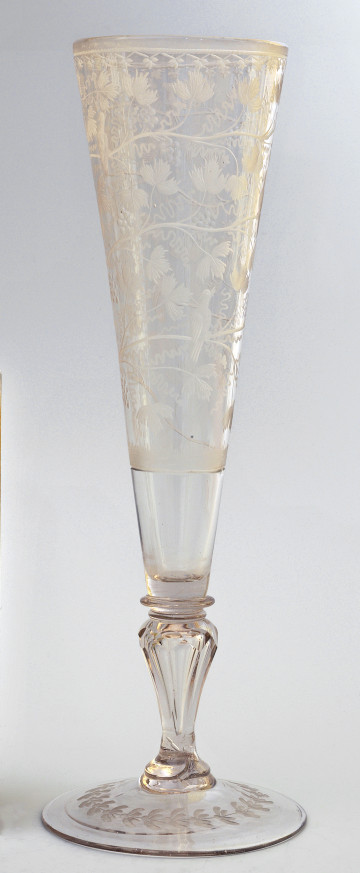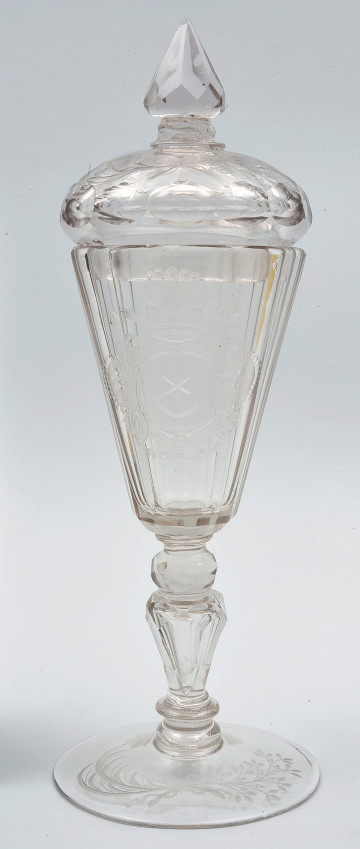
Goblet
Museum of King Jan III's Palace at Wilanów
Part of the collection: Artistic glass
A round plaque with the image of a horseback knight filling its surface almost entirely, covered with enamel with en grisaille decoration against a black background with gildings. The representation is enlivened by colour accents of details in a blue, green, ochre and violet tone. A galloping grey horse, turned right, is bestridden by a bearded knight in full armour and a helmet with a plume, with an icepick in the right hand. A wide sheath with a sword placed in it hangs at his right side. A coat blown by the wind hovers over his back. The horse is covered with a decorative saddlecloth with blue fringes. On the level of the horse’s back, on the saddlecloth, the image of a rampant lion is visible. Around the brink of the upper edge, an inscription written in gold letters (partly crumbled) is visible: ‘Hector Troianus’.
Hector was the eldest son of Priam, King of Troy, and Hecuba, and Andromache’s husband. He was regarded as the bravest Trojan hero, being the terror of the Greek army. According to prophecies, Troy would not fall until he lived. Challenged to a duel by Achilles avenging the death of his friend Patroclus, he died at his hand. After the victory, Achilles tied Hector’s corpse to a cart and carried it around Troy. Finally, he released the corpse to the grieving father for ransom and allowed him to make a solemn funeral.
The plaque belongs to a cycle of decorative representations with images of ‘The Nine Worthies’. The Wilanów collection includes also the second plaque from this cycle with a representation of Joshua. The theme of brave men, known also as ‘Heroes of the World’ or ‘Nine Valiants’, was particularly popular in the late Middle Ages due to Les Voeux du paon (ca. 1310) – a poem by Jacques de Longuyon. It extolled such virtues as courage, faithfulness and honour. They were personified by antique (Hector, Alexander the Great, Julius Caesar), Old Testament (Joshua, David, Judas Maccabeus) and Christian heroes (King Arthur, Charlemagne, Godfrey of Bouillon).
On the basis of scarce original information, we can suppose that the collection of Limoges enamels in Wilanów was presumably created by Aleksander Potocki and expanded by his son August.
The plaque was shown to the Warsaw audience during An Exhibition of Antique and Art Objects in the palace of Count August Potocki and his wife at Krakowskie Przedmieście 32 (today the Museum of the University of Warsaw) in 1856. It is described in the catalogue of this exhibition along with the plaque Wil.203 under item 804.
Joanna Paprocka-Gajek
Dimensions
entire object: height: 30,5 cm, width: 11,2 cm
Technique
carving,grinding
Owner
Museum of King Jan III's Palace at Wilanów
Identification number
Location / status

Museum of King Jan III's Palace at Wilanów

Museum of King Jan III's Palace at Wilanów

Museum of King Jan III's Palace at Wilanów
DISCOVER this TOPIC
Castle Museum in Łańcut
DISCOVER this PATH
Educational path